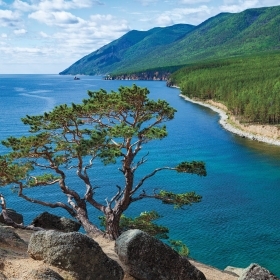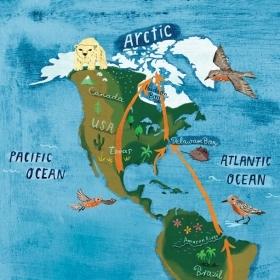Mercy Ngaruiya, or Mama Mercy, as she’s known, lives in a village in southern Kenya in a cluster of low houses surrounded by lush greenery. She wears a loose pink dress and a coif of bouncy curls as she hospitably offers tea. A glossy black cat drapes herself across the table and rests against the serving tray.
Mama Mercy has lived in this rural area for two decades. In the early days, she remembers people selling buckets of meat carved from antelopes and other animals poached from the surrounding bush. Poachers set wire snares or hunted at night by blinding animals with powerful flashlights and chopping them down with machetes. They weren’t faceless criminals. Poachers were men from the community who slung their motorbikes with a dozen rabbit-sized antelopes called dik-diks and sold them to fellow villagers for $1.50 each. One former poacher told me he kept only the dik-dik’s head and intestines for his family to eat; he sold the rest. There were scarcely any jobs in the area other than working small farms to eke out a living—if someone was wealthy enough to own land.
“We had so many problems,” Mama Mercy recalls. “Most people are not educated. They said, ‘What are we going to do for money?’”
People also made charcoal, a ubiquitous cooking fuel across Africa. Most of it is made illegally by cutting down trees and slow-roasting wood in dirt pits to create carbonized hunks. As the forest was cut down for charcoal and wood for cooking, the land grew more arid. Wildlife habitat—tracts of scrubby bush and acacia trees with parasol-like branches—shrank. Water was so coveted that local cattle herders lit fires at water holes to keep animals from drinking.
There was another option for making money. A nearby dusty two-lane road is, improbably, the main highway between Nairobi, Kenya’s capital, and Mombasa, the port for all of East Africa. During the day, scattered vehicles chug along and disappear into the vast horizon.
At night, the road is transformed. It becomes a congested thoroughfare lined chockablock with roaring, groaning trucks. Sometimes, they pull over near wooden shacks that are roadside restaurants and bars. In dim parking lots, women in short skirts and tight tops slip in and out of shadows veiling the vehicles. Trucks rumbling past carry goods to Kenya and neighboring countries. And as is common in this transient profession, drivers often carry sexually transmitted diseases. This trucking route was a hotspot of HIV and AIDS. Some 1.6 million people have HIV in Kenya, making it one of six African countries with the highest incidence of the disease.
“Truckers make friends with women wherever they go,” Mama Mercy says simply. AIDS took its toll here. “People were very sick and thin,” she remembers. “There were funerals every week.”
One night, a Kenyan man accompanies me to the highway. He volunteers to pretend he is a customer and approaches a scantily clad young woman standing on the roadside. Their silhouettes brighten in the headlights of passing trucks. After a few minutes, he returns. The woman would have sex with him for 300 shillings, about $3, he reports. He bargained her down to 200 shillings, or $2. For $10 she would have sex without a condom.
Nature and humanity coexist, confoundingly at times, cheek by jowl in Kenya. Its major highway bisects Tsavo National Park, the country’s largest national park, which is equivalent to the size of Wales. Some 150,000 people, including Mama Mercy, live here in the Kasigau Corridor—more than 500,000 acres of unprotected land wedged between the two halves of the national park. People live among migrating zebra, giraffe, and antelopes, as well as lions, elephants, and buffalo that occasionally crush locals on foot.
Last year, I unexpectedly spent five weeks living in the bush of the Kasigau Corridor to write about a conservation group called Wildlife Works. It found a way to tackle subsistence poaching and deforestation by addressing its root cause: poverty. The group set up an international system to earn money through carbon credits and convinced locals not to cut down trees. In return, village councils got money for preserving the forest and then repaired schools, granted scholarships to children, and built water pipes and storage tanks. The conservation group hired hundreds of locals to work in small clothing workshops, a greenhouse, a tourist lodge, and a mechanic shop, and as wildlife rangers and others who could curb poaching and charcoal making. Wildlife Works also trains women to grow tree seedlings, which it buys and plants in the forest.
Because of those efforts, Mama Mercy and other locals say the area has changed. The forest has flourished. Poaching has drastically declined, and wildlife has returned.
One morning, while I was out running on a trail, a large antelope called a kudu leapt across the path in front of me. At another point, on a patrol with rangers a few miles drive into the bush, we saw buffalo, impala, giraffes, elephants, and even lions. Two decades ago there were no lions here, but now there are several dozen, including two males lounging by a water hole as though poolside in the Hamptons. Once, when driving down the long dirt road to Wildlife Works’ office, I saw a herd of elephants standing nearby, languid in the afternoon sun, with their ears gently flapping.
At night on the highway, plenty of women still await truckers. But Mama Mercy says most of them are from nearby towns; they migrated here to fill the gap when local women started working at the garment workshops run by Wildlife Works. I recall that the young woman willing to have sex without a condom for $10 was not from this town, but a neighboring one.
As more locals got steady jobs with Wildlife Works, they could better support their families. The NGO employs some 300 people. That may not seem like much, but it is now the county’s third-largest employer.
I went to southern Kenya to learn and write about poaching and wildlife and environmental conservation, but found myself talking to people about making a living and struggling to survive in precarious conditions. I played checkers made from bottle caps with rangers who used to poach and make charcoal before they were hired by Wildlife Works. One young man who was orphaned as a boy frankly said he would have been a “street child” if not for scholarships from Wildlife Works. He exceeded his dreams and got a university degree in environmental science, and today, helps with measuring the forest.
Mama Mercy recalls the pitiful sight not long ago of women so poor that they carried precious drinking water in empty Blue Band margarine containers. During the AIDS epidemic here, she started a women’s group to raise awareness about the disease and support those suffering. At first, it was challenging to talk to people about the taboo subject of AIDS.
Now, with awareness and antiretroviral treatment from international aid groups, funerals are no longer a weekly occurrence. Locals are surviving what was a terrifying scourge. Even people with HIV can say, “I’m living positive. I’m happy,” notes Mama Mercy.
But life here is still difficult. I spoke with locals whose farms had been ravaged by elephants. One woman stood in her field of corn flattened by a herd of 13,000-pound pachyderms that devoured her crops. Her year’s income was gone. Another woman’s children were sleepless from waking at night to help scare away marauding elephants by banging pots.
Conflict between humans and wildlife in the area is worsening. A new elevated railway alongside the highway means elephants cannot migrate to the other side of the national park to find food and water. Infrastructure development is vital in this growing country, but there are ways to mitigate its environmental impact—for example, underpasses beneath the railway and better planning to consider wildlife migration.
Tensions are inevitable when wildlife and humans coexist. But one good sign is that the forest is thriving—no small feat when not long ago, the future for its animal and human inhabitants seemed bleak. “Our community has changed. Our community is green, not like before,” says Mama Mercy. “I’m breathing fresh air.”
 Amy Yee ’96 is a journalist who writes for the New York Times, the Economist, NPR, the Washington Post, National Geographic, and others. She is a former correspondent for the Financial Times based in New York and India, as well as a published poet. Follow her on Twitter at @amyyeewrites.
Amy Yee ’96 is a journalist who writes for the New York Times, the Economist, NPR, the Washington Post, National Geographic, and others. She is a former correspondent for the Financial Times based in New York and India, as well as a published poet. Follow her on Twitter at @amyyeewrites.







We ask that those who engage in Wellesley magazine's online community act with honesty, integrity, and respect. (Remember the honor code, alums?) We reserve the right to remove comments by impersonators or comments that are not civil and relevant to the subject at hand. By posting here, you are permitting Wellesley magazine to edit and republish your comment in all media. Please remember that all posts are public.